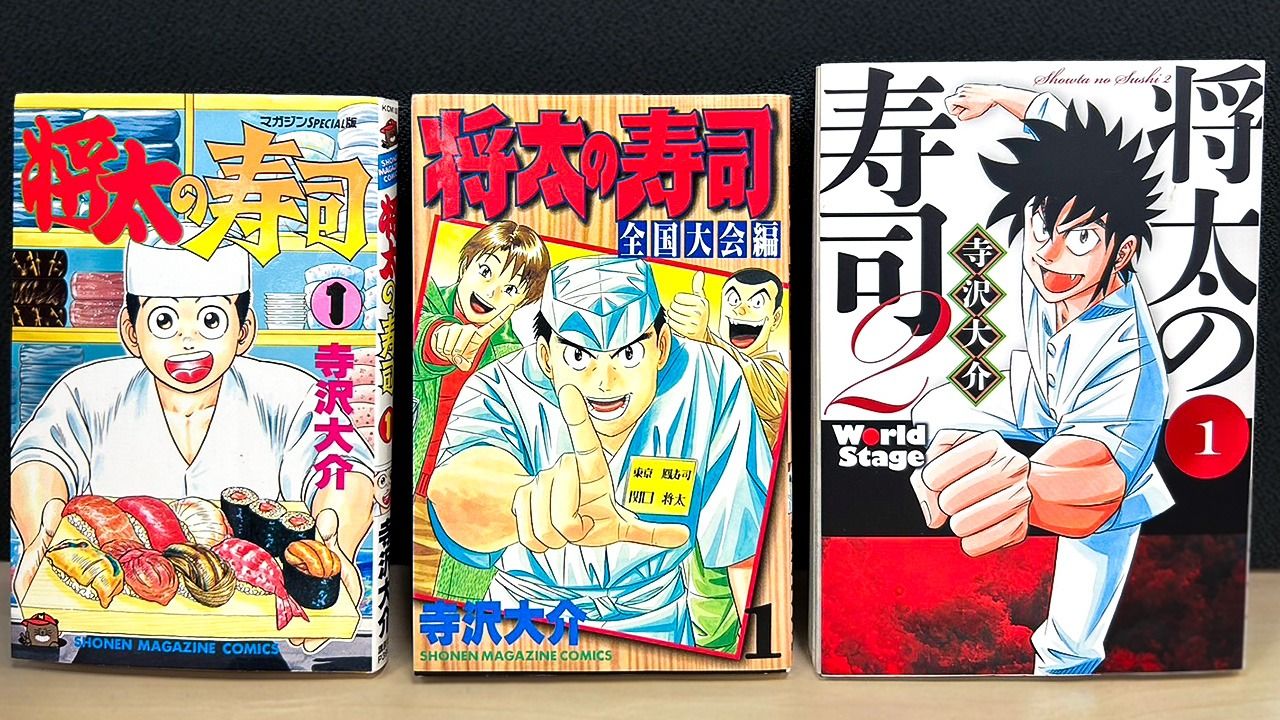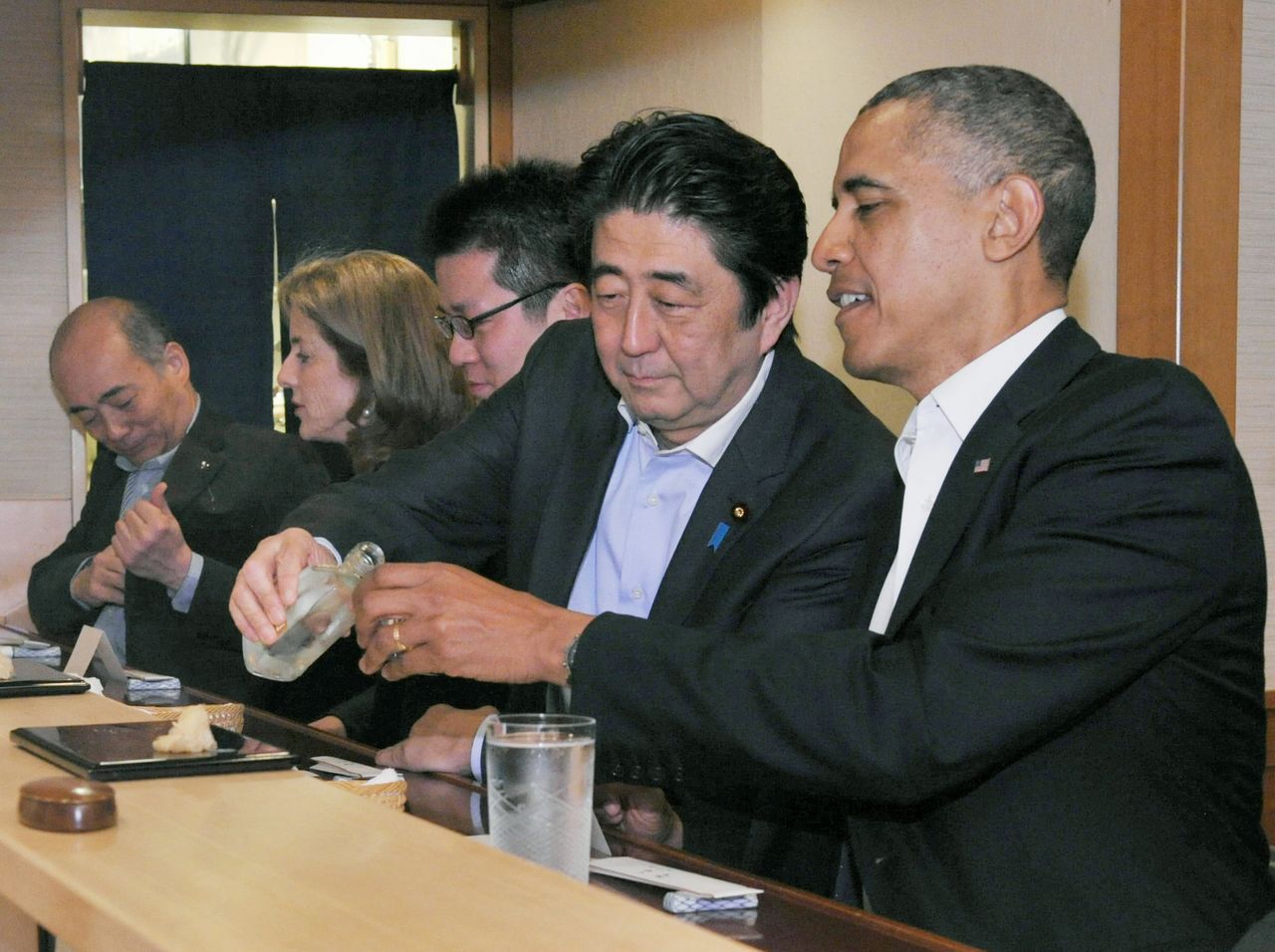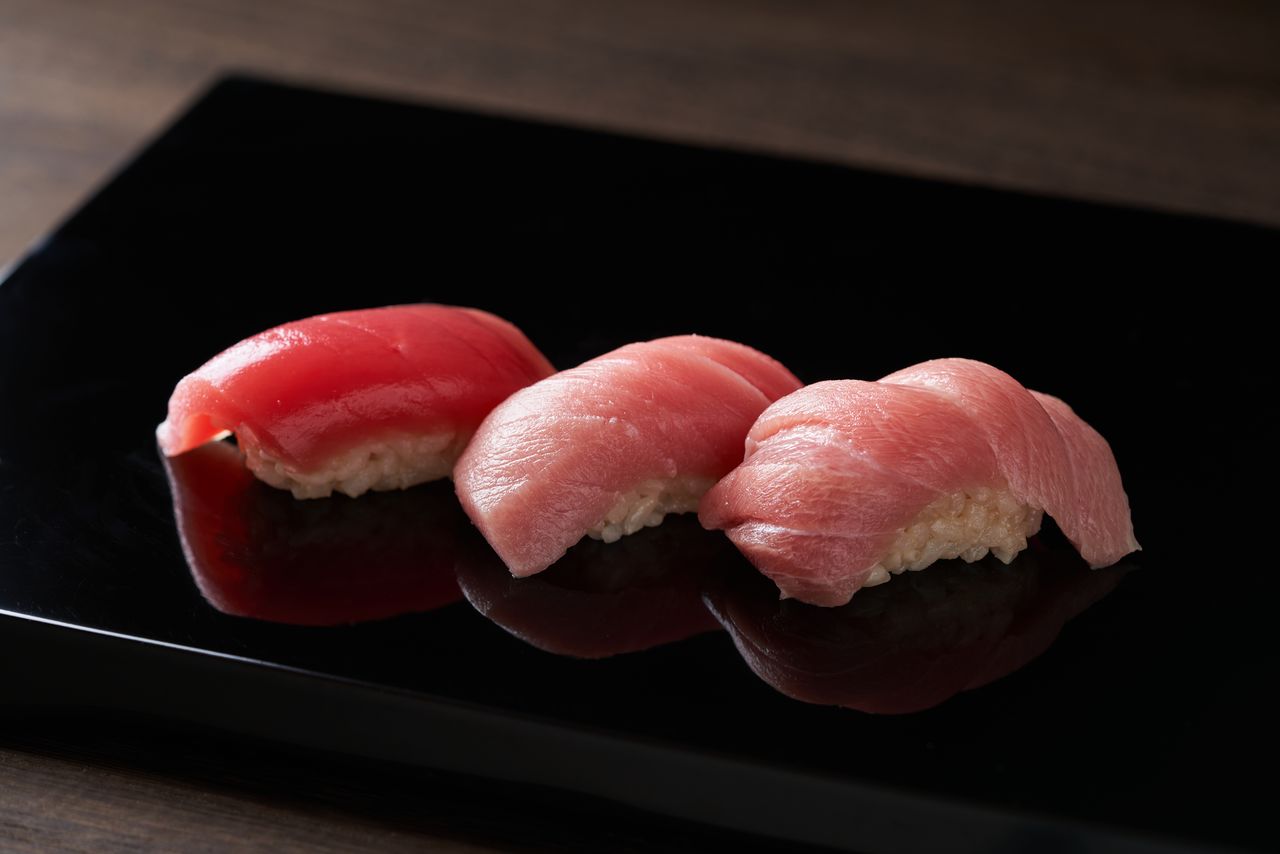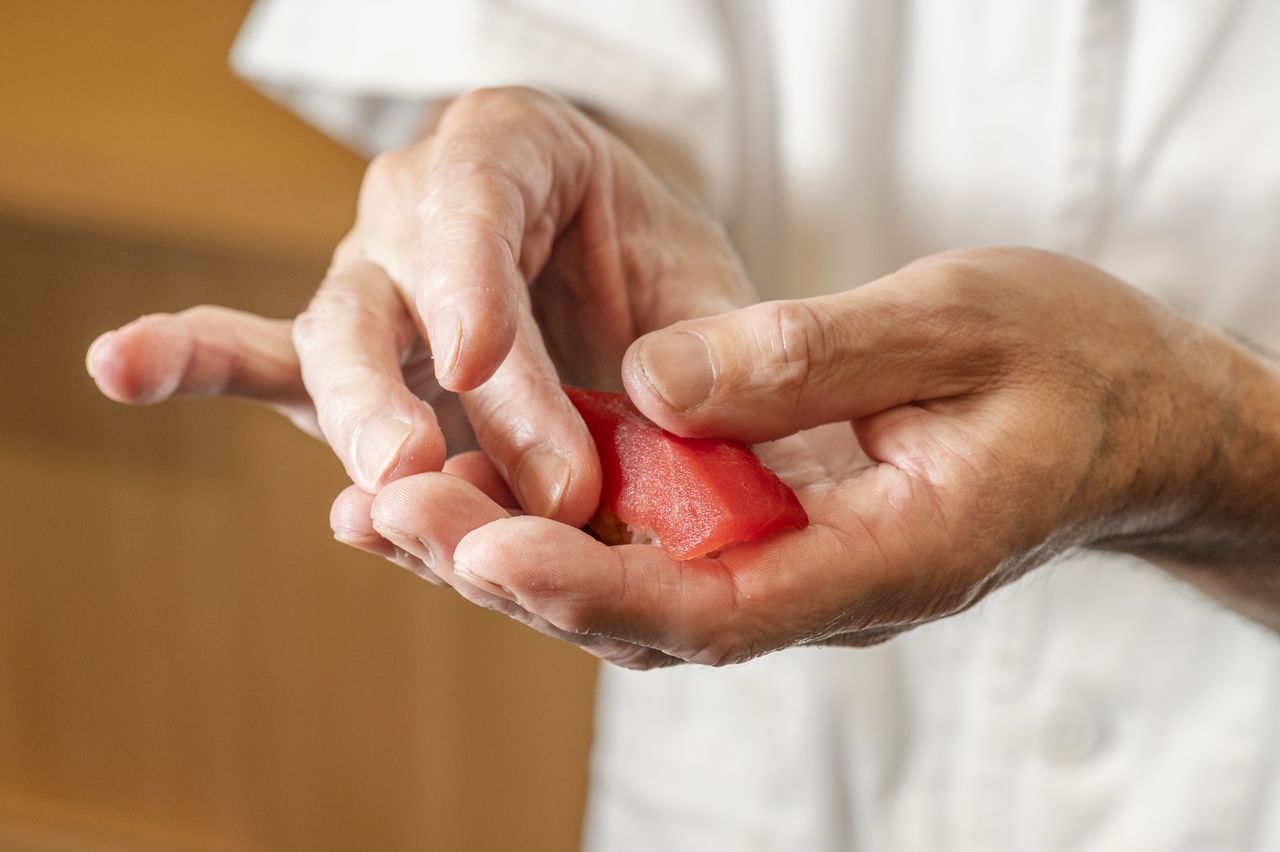
Manga as a Window on Japanese Culture
Celebrating the Craft of Sushi Through Manga
Food and Drink Manga- English
- 日本語
- 简体字
- 繁體字
- Français
- Español
- العربية
- Русский
A Traditional Taste
Every nation boasts its own native cuisine reflecting its culture and environs. For Japan, the most iconic washoku example is sushi, particularly nigirizushi. The dish of vinegared rice pressed into bite-sized clumps and topped with morsels of seafood is a delicacy formed from Japan’s natural landscape of mountains and sea.
When US President Barack Obama came to Japan in 2014, he was treated to a full-course omakase dinner at Sukiyabashi Jirō, a world-renowned sushi restaurant in Tokyo’s ritzy Ginza district. The shop is run by sushi master Ono Jirō, who gained international fame as the subject of the 2011 documentary Jirō Dreams of Sushi. Sushi served at such high-end shops fetches eye-popping prices, but nigirizushi itself was originally a fast food enjoyed by the populace. Even today, low price conveyor-belt sushi shops are extremely popular casual dining spots.

Japanese Prime Minister Abe Shinzō dining with US President Barack Obama at Sukuyabashi Jirō on April 23, 2014. (Courtesy the Cabinet Public Affairs Office; © Jiji)
The popularity of the dish has made it a topic of countless manga. Below, I introduce a few examples of sushi-themed works that explore the artisanal spirit of the cuisine.
The Roots of the Craft
Nigirizushi was born in the eighteenth century in the feudal capital of Edo (now Tokyo). Sushi Ichi! by Ogawa Etsushi depicts the sushi artisans of the period. At the time, the sushiya yokochō district in what is now Sumida was home to a concentration of sushi shops that ranged from high-end gourmet spots to cramped street stalls.
Sushi Ichi! centers around the character Taisuke, a sushi chef who plies his trade at Nanohana Sushi. A wide-eyed, good-natured master of the cuisine, Taisuke has earned the nickname Shippū, meaning “fresh breeze,” in recognition of his amicable personality. An upper-ranked ōzeki on the sushiya yokochō rankings and a frequent champion at sushi contests, he is as deft at shaping sushi as warming hearts.
The waters facing Edo produced fresh seafood in abundance for the hungry denizens of the capital. Nigirizushi, though, arose from environmental changes and innovations in seasoning.
The star of sushi today is maguro or tuna, but this was not always the case. In the first half of the nineteenth century, shifts in the currents in the Sea of Japan brought a sudden rise in tuna catches. The fish was unpopular as its meat was considered overly fatty and was difficult to preserve. In fact, it was valued more as fertilizer for farming than as food. However, the advent of richer types of soy sauce with higher salt content made it easier to preserve tuna. Marinated in soy sauce and served over hand-formed pods of vinegared rice, tuna soon became a staple of hard-working Edoites.

From left: akami, chūtoro, and ōtoro. The different names reflect different parts of the fish and amount of fattiness. (© Pixta)
While nigirizushi is a fairly straightforward dish consisting of a topping (neta) over vinegared rice (shari), proper preparation requires an incredibly high level of skill. Forming nigiri demands a delicate balance of firm pressing to ensure that the rice stays together when picked up but remains light enough to allow the morsel to crumble easily once eaten. Sushi is a culinary world juxtaposing strength and flexibility.
The manga Edomae sushi shokunin Kirara no shigoto (The Work of Edomae Sushi Artisan Kirara), written by Hayakawa Hikari and illustrated by Hashimoto Kozō, follows the protagonist Kirara as she masters that elevated skill.
Japanese culinary craftsmanship was traditionally a male domain, but Kirara learned to make sushi from her grandfather. As a young girl, she had already mastered the complex forming technique called hontegaeshi that produces an ideal bundle of rice resembling an open fan, or jigami. The rice is so light and fluffy that even if it were topped with cheap seafood, the result would be every bit as delicious as that served at a Michelin-starred shop.
Kirara is offered a position as a master chef at a new Ginza shop, but her true dream is for her sushi to be enjoyed by all. She turns the position down in the end and focuses on further honing her skills in hopes of reopening the neighborhood sushi shop that her grandfather once ran.
The Sushi Manga Pièce de Résistance
Mastering the demanding skills to become a sushi shokunin, as with any of Japan’s traditional professions, requires strength of character and unwavering dedication. In that, it resembles the world of sumō, where a yokozuna, or grand champion, cannot merely be strong, but must also be dignified.
The most realistic depiction of the path to becoming a true sushi artisan is found in the sushi manga pièce de résistance, Shōta no sushi by Terasawa Daisuke.
The work depicts protagonist Sekiguchi Shōta, who was born into a sushi family that runs the neighborhood shop Tomoe Sushi in Otaru, Hokkaidō. The restaurant finds its business threatened when a branch of a mega-chain sushi shop opens nearby. Shōta enters a sushi contest in hopes of saving his family business. Although he does not win, his dedication and cleverness draws the attention of Tokyo sushi master Ōtori Seigorō, who takes him to train at his shop in the capital. Shōta is determined to become Japan’s best sushi chef and to build his family’s shop into the top sushi restaurant in the nation.
I call it training, but Shōta does not at first set out practicing how to form shari rice. The world of sushi has an old saying, “cook shari for three years,” reflecting the idea that even the most basic skill of preparing the vinegared rice is one that requires extensive training.
The first year Shōta spends in what is called oimawashi, a kind of odd-job role that includes cleaning, dishwashing, and, eventually, cooking the staple topping of rolled omelet.
Traditionally, the path upward for a trainee is long, and it takes seven or eight years before an individual finally is allowed to form sushi. But even then, no one teaches the necessary skills directly. Rather, a trainee has to watch and learn, using the time between chores to observe what senior cooks are doing and copy them.

There are a variety of ways to form nigirizushi. The manga Shōta no sushi introduces a variety of secret techniques. (© Pixta)
Training to be a sushi chef is a rigorous task. There are stories from Sukiyabayashi Jirō about trainees quitting the same day they start. In the manga, Shōta feels the pressure of his daily toils, but his goal of restoring his family shop sustains him.
Beyond his chores, Shōta sets out on his own to master other skills. He gets up before dawn to visit fish markets to study how to choose the best seafood and visits other chefs to learn shari-making techniques. He sometime spends days with no more than two hours of sleep, but he earns the support of those around him, and his skill progress rapidly.
The work conveys such traditional views as that solitary training not only sharpens skills but also sharpens the spirit, and that no matter one’s ability, a person cannot become a true artisan without dedication from the heart.
The ideals behind these themes reflect the view that anyone can improve themselves if they throw themselves into their work wholeheartedly, and that with the right mindset, even mundane activities can serve as training, as in Zen.
Shōta no sushi shares both the temperament of Japan’s shokunin and basic information about sushi, such as that matured rice is better suited to the dish than freshly harvested grain.
The Spirit Remains as the Times Change
Shōta no sushi was first serialization in 1992. In today’s world, though, with sushi a global phenomenon, there is doubt as to whether the harsh training Shōta endures to become a master sushi chef is realistic, or if forcing trainees to spend years on menial chores is simply a way to get cheap, easy labor.
Unsurprisingly, fewer young people are choosing to pursue sushi as a profession. There are now specialty schools that teach sushi skills, reflecting the attitude that rather than learning by watching, it is more efficient to develop skills through instruction and practice, a view I can sympathize with.
Is there any merit in the old idea that harsh training is the only way to strengthen the spirit and nurture a person? In Shōta no sushi, a senior trainee named Saji Anto takes a strong disliking to Shōta, even going so far as to hide and destroy letters sent to him from an old girlfriend. He is a truly unpleasant character. However, he too is striving to become a sushi chef and eventually grows to become a fine, respected man. In a sense, his transformation provides a convincing answer to the question.
Conveyor-belt sushi shops offering reasonably priced fare are making inroads overseas alongside high-end shops, demonstrating sushi’s broadening appeal. My hope is that sushi will remain a casual dining option, with people being able to stack up plates and enjoy their meals in an informal setting.
Yet, even today, there is someone somewhere who is in training, honing their spirit to become a sushi artisan. And there are master chefs rising at the crack of dawn to purchase choice selections of seafood and spending hours preparing ingredients. The existence of such dedicated artisans is one of sushi’s greatest appeals. Contemplating that over a serving of sushi is one way to savor the dish even more deeply.
(Originally published in Japanese. Banner photo: Shōta no sushi (left) ran in Weekly Shōnen Magazine from 1992 to 1997 and was followed by Shōta no sushi zenkoku taikaishū, which ran from 1992 to 2000, and Shōta no sushi 2 World Stage, published from 2013 to 2015. Photo by Nippon.com.)
Related Tags
manga Japanese cuisine sushi pop culture Manga and Anime in Japan
